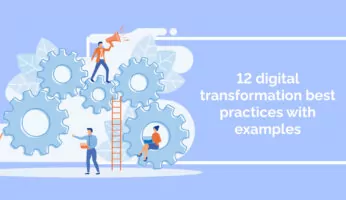![What Are Human Resources Management Systems? [An HRMS FAQ]](https://change.walkme.com/wp-content/uploads/2021/10/Human-resources-management-systems.webp)
Are human resources management systems worth the investment?
In this post, we’ll learn what these platforms do, their core features, and whether they are worth the investment.
What Are Human Resources Management Systems (HRMSs)?
A human resources management system, or HRMS, is designed to do exactly what its name suggests:
- Assist HR managers with core HR management tasks, from overseeing attendance to performance management
- Integrating HR software with other organizational software
- Providing HR automation features
- Offering insight into HR functions and the enterprise through analytics
As organizations grow in size and complexity, and as the modern workplace becomes more digital, it is important for HR to adopt software that can keep up with these changes.
HRMSs enable HR managers to minimize complexity while maximizing productivity.
Why Invest in a Human Resources Management System?
As with most enterprise-grade SaaS solutions, HRMSs greatly simplify and enhance everyday HR processes.
The results:
- Improved efficiency and lower HR costs. HMRS solutions streamline and integrate so many HR functions that employers almost always end up cutting costs and improving efficiency across the HR department. These savings can come in the form of lower labor costs, less waste, simpler workflows, and improved business outcomes.
- Improved outcomes for the organization. Perhaps one of the most important reasons to invest in an HMRS is the better outcomes that these solutions provide. From talent management to workforce planning, these systems can generate a positive ROI across a number of HR functions. As a result, HR ends up providing more value to the organization.
- A better employee experience. Since HRMSs positively impact the HR department, their adoption usually drives improvements in the employee experience. This, intern, can drive other improvements to employee metrics such as employee sentiment, engagement, productivity, and performance.
- A better experience for HR personnel. HRMSs also improve the experience for HR staff. Since these platforms simplify and streamline workflows, HR staff can focus on more value-added activities. This can lighten workloads and improve the workplace experience for HR professionals.
For many organizations, an HRMS is not only beneficial, it is essential to staying relevant and competitive in the digital age. Without systems such as these, large organizations will simply lose too much money and time. As an organization grows, therefore it must think about how to streamline HR processes with HRMSs.
HRMS vs. HCM Platform
HMRS is often used synonymously with terms such as Human Resources Information System and HCM platform.
These HR software applications are designed specifically for large organizations. As we will see below, they include a great many features that are useful for enterprises and large-scale organizations, but they are simply too complex for smaller companies.
Smaller organizations also need HR software, but these typically include different features and they go by a different name.
Many are simply called HR software or HR platforms. While they include the key features needed by small businesses, such as payroll and attendance features, they do not include more complex features, such as talent management and employee experience management.
It is also worth noting that there are other, more specialized types of HR software such as those that focus exclusively on recruitment, time, tracking, or payroll.
For example, an applicant tracking system is specifically designed to streamline the recruitment process. In some cases, an organization may only need to invest in one software application, though it is worth remembering that HRMSs often include features dedicated to functions such as applicant racking.
What Are the Features Offered in HRMSs?
Features will vary from platform to platform, but they often include:
- Payroll
- Attendance and time tracking
- Budgeting
- Recruitment
- Benefits
- Absence and leave management
- Onboarding
- Compliance management
- Talent management
- Workforce management
- Performance management
- Self-service HR help desks
- Reporting and analytics
All of these features are typically included under a single dashboard.
Is an HRMS Worth the Investment?
To determine whether an HMRS is worth your organization’s time and money:
- Analyze existing HR costs
- Examine existing HRMS solutions
- Perform gap analyses and business impact analyses to determine the impacts of adopting these platforms
- Assess the potential ROI of the investment based on these calculations
When performing these analyses, it’s also important to factor in the cost of the transition. New software always comes with new hurdles, and it is important to address those challenges with a structured digital adoption strategy.
Developing a digital adoption strategy for implementing your HMRS can improve digital engagement, employee performance, and ultimately the ROI of your software investment.
How Do You Choose the Right HRMS?
There are several factors to consider when examining HMRSs.
A few of these include:
- Your budget
- The features you need
- Your existing digital ecosystem
- The size of your organization
Also, keep in mind that HMRS solutions can go by different terms, such as HCM platforms. In fact, HCM platform is often the preferred term for many of the most sophisticated HMRSs.For more information on these solutions, see this article on driving HCM software change.
WalkMe Team
WalkMe spearheaded the Digital Adoption Platform (DAP) for associations to use the maximum capacity of their advanced resources. Utilizing man-made consciousness, AI, and context-oriented direction, WalkMe adds a powerful UI layer to raise the computerized proficiency, everything being equal.



